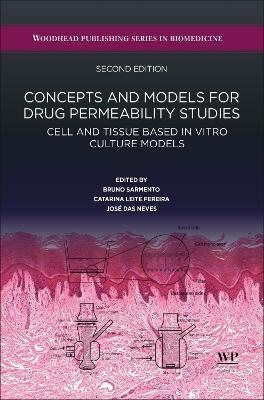
Concepts and Models for Drug Permeability Studies
Woodhead Publishing (Verlag)
978-0-443-15510-9 (ISBN)
Concepts and Models for Drug Permeability Studies: Cell and Tissue Based in Vitro Culture Models, Second Edition, is a critical reference for drug discovery and drug formulation scientists interested in delivery systems intended for the administration of drugs through mucosal routes and other important tissue barriers (e.g. the BBB). Researchers studying mucosal biology can use this book to familiarize themselves and exploit the synergic effect of mucosal delivery systems and biomolecules.
BBruno Sarmento is Principal Investigator and Group Leader at Institute for Research and Innovation in Health (i3S), University of Porto (UP), and Invited Associate Professor at Instituto Universitário de Ciências da Saúde (IUCS), Portugal. His research is focused on the development of mucosal tissue engineering models to validate functionalized nanomedicines and to perform in vitro/in vivo correlation. He has also established functionalized nanomedicines for mucosal drug delivery of drug with poor mucosal bioavailability. He published more than 400 papers in international journals, most in top journals (20000 Scopus citations; H-index 73). He edited 5 books, participated in more than 50 invited/selected talks in national and international meetings and was awarded several distinctions. He has supervised/co-supervised 15 Post-Docs, 50 PhD students and 40 MSc students. He is editor of European Journal of Pharmaceutical Sciences, and member of the Editorial Advisory Board of several international journals, including the Journal of Controlled Release, Expert Opinion on Drug Delivery and Pharmaceutics. Bruno Sarmento was the first Chair of the Nanomedicine and Nanoscale Delivery Focus Group of the Controlled Release Society (CRS) and is now Director-at-Large of CRS and member of CRS College of Fellows. Dr. Leite Pereira is a Junior Researcher at Institute for Research and Innovation in Health (i3S), University of Porto (UP). Her research focus on the development of advanced 3D in vitro models as preclinical tools for novel drugs/nanomedicines screening, using multi-compartmentalized in vitro systems. Throughout her path Catarina has been able to translate her scientific achievements into the publication of 27 papers in leading peer-reviewed journals (h-index: 15, >500 citations). The quality of the scientific production can be ascertained by the several selected oral presentations in prestigious international conferences and invitations to act as expert reviewer in international funding agencies. Dr. das Neves is Assistant Researcher at Institute for Research and Innovation in Health (i3S), University of Porto (UP), and Invited Assistant Professor at Instituto Universitário de Ciências da Saúde (IUCS), Portugal. His research focuses on mucosal drug delivery, particularly via the vaginal and rectal routes. For instance, he developed and expanded on the use and understanding of cell- and tissue-based models for evaluating nanotechnology-based drug delivery systems for local therapy and prophylaxis. He is the author of 77 (h-Index: 53) peer-reviewed articles in the broad field of drug delivery, editor of four scientific books and guest editor of seven special issues in international journals. José also serves as editorial board member of international journal in the field of drug delivery and biological sciences (Pharmaceutics (MDPI), Nanomaterials (MDPI), PLOS ONE (PLoS), and Drug Delivery Letters (Bentham)), and as Director of Scientific Communications of the Controlled Release Society.
1. Introduction
2. Importance and applications of cell- and tissue-based in vitro models for drug permeability screening in earlystages of drug development
Section I: Cell-based in vitro culture models for drug permeability studies: Immortalized and primary isolated cells
3.1. Cell-based in vitro models for buccal permeability studies
3.2. Cell-based in vitro models for gastric permeability studies
3.3. Cell-based in vitro models for intestinal permeability studies
3.4. Cell-based in vitro models for nasal permeability studies
3.5. Cell-based in vitro models for pulmonary permeability studies
3.6. Cell-based in vitro models for vaginal permeability studies
3.7. Cell-based in vitro models for transcorneal permeability studies
3.8. Cell-based in vitro models for dermal permeability studies
3.9. Tissue-based in vitro and ex vivo models for bloodebrain barrier permeability studies
3.10. Cell-based in vitro models for placental barrier permeability studies
Section II: Tissue-based in vitro and ex vivo models for drug permeability studies
4.1. Tissue-based in-vitro models for buccal permeability studies
4.2. Tissue-based in vitro and ex vivo models for intestinal permeability studies
4.3. Tissue-based in vitro and ex vivo models for nasal permeability studies
4.4. Tissue-based in vitro and ex vivo models for pulmonary permeability studies
4.5. Tissue-based models for vaginal permeability studies
4.6. Tissue-based models for ocular permeability studies
4.7. Tissue-based in vitro and ex vivo models for dermal permeability studies
4.8. Tissue-based in vitro and ex vivo models for bloodebrain barrier permeability studies Malgorzata Burek, Ellaine Salvador and Carola
4.9. Tissue-based ex vivo models for placental barrier permeability studies
Section III: Miniaturized models for drug permeability studies
5.1. Organ-on-chip models for intestinal permeability studies
5.2. Organ-on-chip models for pulmonary permeability studies
5.3. Organ-on-chip models for bloodebrain barrier permeability studies
5.4. Organ-on-chip models for other mucosal permeability studies
Section IV: Complex models for drug permeability studies
6.1. Multicompartmental dynamic models for permeability studies
6.2. Organoid-based models for permeability studies
7. Correlation between cell- and tissue-based in vitro models for drug permeability screening with in vivo situation: modeling and functional extrapolation
| Erscheinungsdatum | 03.02.2024 |
|---|---|
| Sprache | englisch |
| Maße | 152 x 229 mm |
| Gewicht | 1000 g |
| Themenwelt | Medizin / Pharmazie ► Medizinische Fachgebiete ► Pharmakologie / Pharmakotherapie |
| Medizin / Pharmazie ► Pharmazie | |
| Technik | |
| ISBN-10 | 0-443-15510-0 / 0443155100 |
| ISBN-13 | 978-0-443-15510-9 / 9780443155109 |
| Zustand | Neuware |
| Informationen gemäß Produktsicherheitsverordnung (GPSR) | |
| Haben Sie eine Frage zum Produkt? |
aus dem Bereich


